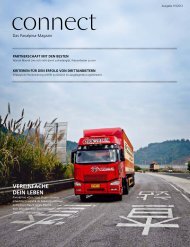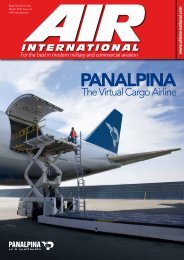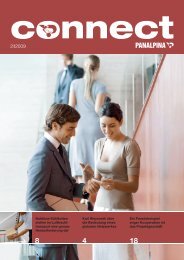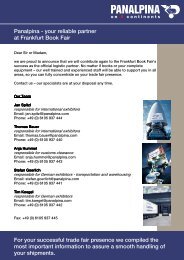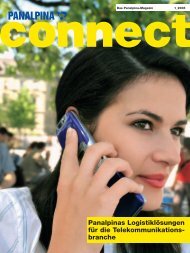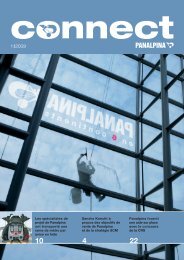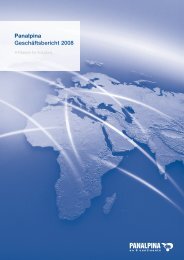Panalpina Annual Report 2006
Panalpina Annual Report 2006
Panalpina Annual Report 2006
You also want an ePaper? Increase the reach of your titles
YUMPU automatically turns print PDFs into web optimized ePapers that Google loves.
Consolidated and <strong>Annual</strong> Financial Statements <strong>2006</strong><br />
Where a reassessment is made, lease accounting shall commence or cease from the date on which the change in<br />
circumstances gave rise to the reassessment for the first, third or forth above mentioned scenarios and at the date of<br />
renewal or extension period for the second scenario.<br />
For arrangements entered into prior to 1 January 2005, the date of inception is deemed to be 1 January 2005 in accordance<br />
with the transitional requirements of IFRIC 4.<br />
Finance leases, which transfer to the Group substantially all the risks and benefits incidental to ownership of the leased item,<br />
are capitalized at the inception of the lease at the fair value of the leased property or, if lower, at the present value of the<br />
minimum lease payments. Lease payments are apportioned between the finance charges and reduction of the lease liability<br />
so as to achieve a constant rate of interest on the remaining balance of the liability. Charged finance costs are reflected in<br />
the income statement.<br />
Capitalized leased assets are depreciated over the shorter of the estimated useful life of the asset and the lease term, if there<br />
is no reasonable certainty that the Group will obtain ownership by the end of the lease term.<br />
Operating lease payments are recognized as an expense in the income statement on a straight line basis over the lease term.<br />
Business combinations and goodwill<br />
Business combinations are accounted for using the acquisition accounting method. This involves recognizing identifiable<br />
assets and liabilities of the acquired business at fair value.<br />
Goodwill acquired in a business combination is initially measured at cost, being the excess of the cost of the business<br />
combination over the Group’s interest in the net fair value of the acquiree’s identifiable assets, liabilities and contingent<br />
liabilities. Following initial recognition, goodwill is measured at cost less any accumulated impairment losses. For the<br />
purpose of impairment testing, goodwill acquired in a business combination is, as of the acquisition date, allocated to each<br />
of the Group’s cash generating units, or groups of cash generating units, that are expected to benefit from the synergies<br />
of the combination, respective of whether other assets or liabilities of the Group are assigned to those units or groups of<br />
units. Each unit or group of units represents the lowest level within the Group at which the goodwill is monitored for internal<br />
management purposes and is not larger than a segment based on either the Group’s primary or the Group’s secondary<br />
reporting format determined in accordance with IAS 14 Segment <strong>Report</strong>ing.<br />
Where goodwill forms part of a cash-generating unit and part of the operation within that unit is disposed of, the goodwill<br />
associated with the operation disposed of is included in the carrying amount of the operation when determining the gain<br />
or loss on disposal of the operation. Goodwill disposed of in this circumstance is measured based on the relative values of<br />
the operation disposed of and the portion of the cash-generating unit retained.<br />
When subsidiaries are sold, the difference between the selling price and the net assets plus cumulative translation<br />
differences and unamortized goodwill is recognized in the income statement.<br />
Intangible assets<br />
Brands, trademarks, customer lists and relationship, software licenses and other intangible assets are initially recorded at<br />
cost. The cost of intangible assets acquired in a business combination is the fair value as of the date of acquisition. Acquired<br />
intangible assets other than a business combination, the initial fair value will be recorded. Following initial recognition,<br />
intangible assets are carried at cost less any accumulated amortization and any accumulated impairment losses. Internally<br />
generated intangible assets, excluding capitalized development costs, are not capitalized and expenditure is reflected in<br />
the income statement in the period in which the expenditure is incurred.<br />
Intangible assets are amortized on a straight-line basis beginning from the point when they are available for use and over the<br />
useful economic life and assessed for impairment whenever there is an indication that the intangible asset may be impaired.<br />
The estimated useful life for software licenses is three to five years; all other intangible assets a maximum of ten years.<br />
The amortization period for an intangible asset with a finite useful life is reviewed at least at each financial year-end. Changes<br />
in the expected useful life of future economic benefits embodied in the asset is accounted for by changing the amortization<br />
period, as appropriate, and treated as changes in accounting estimates. The amortization expense on intangible assets<br />
with finite lives is recognized in the income statement.<br />
Computer software developed internally is capitalized only when the Group can demonstrate the technical feasibility of<br />
completing the intangible asset so that it will be available for use or sale, its intention to complete and its ability to use or sell<br />
the asset, how the asset will generate future economic benefits, the availability of resources to complete the software<br />
and the ability to measure reliably the expenditure during the development. During the period of development, the asset<br />
is tested for impairment annually. Following the initial recognition of the development expenditure, the capitalized software<br />
development costs are amortized over their estimated useful life (not exceeding three years) and carried at cost less<br />
any accumulated amortization and accumulated impairment losses. Amortization begins when development is complete and<br />
the asset is available for use. Costs of maintaining and modifying existing programs are charged to the income statement.<br />
<strong>Panalpina</strong> <strong>Annual</strong> <strong>Report</strong> <strong>2006</strong> 81


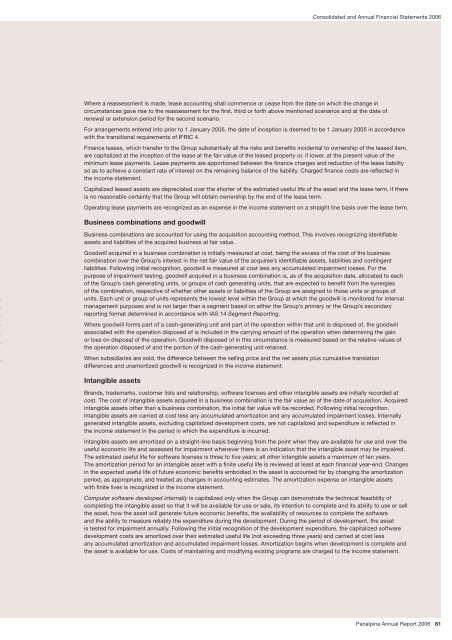
![Eigenes Luftfrachtnetzwerk [pdf | 244 KB] - Panalpina](https://img.yumpu.com/23347328/1/184x260/eigenes-luftfrachtnetzwerk-pdf-244-kb-panalpina.jpg?quality=85)
![Übersicht Panalpina [pdf | 240 KB]](https://img.yumpu.com/22547731/1/184x260/ubersicht-panalpina-pdf-240-kb.jpg?quality=85)
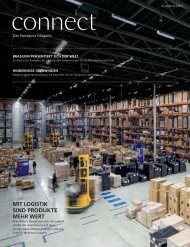
![Seefracht [pdf | 181 KB] - Panalpina](https://img.yumpu.com/22234724/1/184x260/seefracht-pdf-181-kb-panalpina.jpg?quality=85)
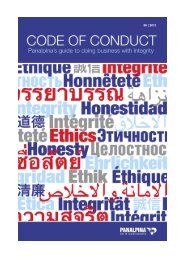
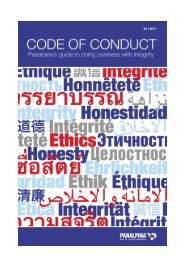

![Annual Report 2012 [pdf | 1 MB] - Panalpina](https://img.yumpu.com/15342099/1/184x260/annual-report-2012-pdf-1-mb-panalpina.jpg?quality=85)
